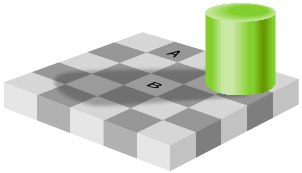Lesson 3
1. Lesson 3
Module 7: Absolute Value and Reciprocal Functions
Lesson 3: Absolute Value Equations
Focus

In the illustration, notice that the green cylinder casts a shadow on the checkerboard. Study the colours of the squares marked A and B. They appear to be different shades of grey, but are they? Use a screen capture tool to capture each square. Place them side by side and compare. What do you notice?
The illustration is an example of an optical illusion. Creating an optical illusion takes skill. Your creation needs to appear to reveal one thing, but in fact, it reveals something else. The observer must differentiate between what is real and what is extraneous to have a true sense of what he or she is seeing.
In this lesson you will study absolute value equations. Like optical illusions, you will find that you may generate solutions that appear to be mathematically correct, but are in fact extraneous. You will learn both graphical and algebraic strategies for determining the solutions of absolute value equations.
Outcomes
At the end of this lesson you will be able to
- solve, graphically, an absolute value equation with or without technology
- solve, algebraically, an equation with a single absolute value, and verify the solution
- explain why the absolute value equation
 has no solution
has no solution
- determine and correct errors in a solution to an absolute value equation
- solve a problem that involves an absolute value function
Lesson Questions
In this lesson you will investigate the following questions:
- How can the roots of absolute value equations be determined?
- Why are extraneous roots obtained sometimes when absolute value equations are solved algebraically?
Assessment
Your assessment may be based on a combination of the following tasks:
- completion of the Lesson 3 Assignment (Download the Lesson 3 Assignment and save it in your course folder now.)
- course folder submissions from Try This and Share activities
- additions to Module 7 Glossary Terms and Formula Sheet
- work under Project Connection
Materials and Equipment
You will need a graphing calculator and graph paper.